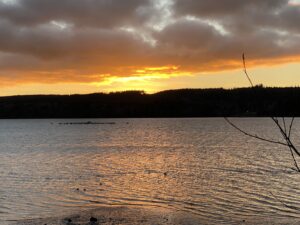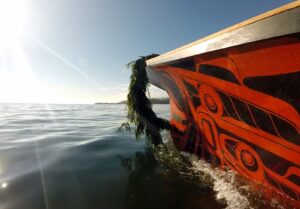History & Culture

The Port Gamble S’Klallams are the “Strong People”—a name well-earned over generations of grit and resilience used to protect the people and places they have always held dear.
For thousands of years before the arrival of European settlers, the Port Gamble S’Klallam lived in seasonal and permanent villages extending across and beyond the borders of the Olympic Peninsula. The Port Gamble S’Klallam hunted, fished, and gathered from north of the San Juans, south into the Olympics, west into the Straits of Juan De Fuca, and east into the hood canal.
The S’Klallams lived in partnership with the land and its resources, while respecting the territory of neighboring tribes. Like many tribes, the S’Klallams had no concept of land or animal ownership as defined by the arriving Europeans.
The S’Kallams were deep rooted throughout the Hood Canal area, sharing sites in Port Townsend and Port Gamble with the Chemakum when two events would fundamentally shape their future.
The first was the arrival of Captain Josiah P. Keller at Port Gamble in 1853, who saw an excellent location for a sawmill, even though the S’Klallams had long established a village on the site. Oral history indicates that Keller incentivized the forced relocation across Port Gamble Bay to Point Julia with offerings of firewood, lumber to build homes, and Christmas “treats”.
Also in 1853, delegates for the newly established Washington territory arrived to negotiate a treaty with the S’Klallams and other area tribes. The talks were ill-conceived from the start: they were conducted not in each tribe’s native tongue, but in Chinook Jargon, a pidgin trade language with just a few hundred words. Add in the foreign concept of private property ownership and its clear the Indian Agents responsible for negotiating the treaties, were taking advantage of the situation.
Nonetheless, in 1855, the Point No Point Treaty was signed. In the agreement, tribes ceded the right to three-quarters of a million acres of land to the United States government. In return, they reserved their rights to hunt, fish, and gather shellfish and plants in their “usual and accustomed grounds and stations.” The S’Klallams—along with other tribes—specifically sought to preserve their right to hunt and fish as they had always done. Unfortunately, the Treaty ceded their access to the land in favor of the ownership of white settlers as the S’Klallams were assigned to the Skokomish Reservation, over 100 miles away from their ancestral home in and around Hood Canal. Many S’Klallams refused to leave. By 1864, Keller and his business partners were awarded ownership of Port Gamble and surrounding lands, including Point Julia.
Without a land base and recognizing that the rules had fundamentally changed, some S’Klallams began to formally purchase land. Some did this with money earned while working at the mill and living in the village at Point Julia.
On December 8, 1886, S’Klallam ancestors Charley Jones, John Soloman, and Cookhouse Charley each purchased 11 acres of land close to Point Julia. Much of the land obtained by the S’Klallams was close to Point Julia: in 1891, Joseph Anderson was issued 80 acres under the Indian Homestead Act of 1884; in 1897, George Dan purchased 40 acres; in 1903, Jacob Jones purchased 17 acres; in 1921, Ed Purser bought 40 acres. Much of this land was later divided into parcels that were all, over time, sold or transferred to other S’Klallams. The process of purchasing the land, and then conveying that land within S’Klallam families, signifies the S’Klallam’s perseverance to continue to live where they always had by maintaining residence on land near Point Julia. Unfortunately, some of the land rightfully purchased by S’Klallams was eventually lost due to tax disputes.
 While some S’Klallams were able to build homes on their own land, many others lived in structures on the sand spit at Point Julia, where they were subject to tides and extreme weather conditions. Homes often flooded causing unsafe living conditions.
While some S’Klallams were able to build homes on their own land, many others lived in structures on the sand spit at Point Julia, where they were subject to tides and extreme weather conditions. Homes often flooded causing unsafe living conditions.
By 1922—67 years after the signing of the Point No Point Treaty—the Port Gamble S’Klallams still had no land base. Seeking to be compensated for the land they had ceded under the terms of the Treaty, Tribal members hired an attorney to file a claim against the United States government. In 1925, a settlement was reached to the sum of $400,000, which was to be paid per capita to the S’Klallam members. Ultimately, 533 S’Klallam members received a total of $722 (approximately $12,000 in 2023) to settle individual claims arising from the Treaty.
This settlement, however, did not resolve the S’Klallam’s main issue stemming from the Treaty. While attempts were made to provide a “home” through private land ownership, the Tribe still lacked a centralized land base.
With the Indian Reorganization Act of 1934, land and water rights began to be acquired for the creation of new reservations. In 1938, 1,234 acres on the tip of the Kitsap peninsula were proclaimed “for the use and benefit of the Port Gamble Band of Clallam Indians.”
After the establishment of the reservation, the houses at Point Julia were condemned by the Health Department and eventually burned to the ground. While these structures were ramshackle at best, they were also the only homes some Port Gamble S’Klallam had ever known. Many Elders refused to leave, sitting by in protest as government officials packed out their belongings.
The Port Gamble S’Klallam Tribe had to wait 88 years  for a reservation or any compensation for the lands they ceded, but by standing their ground, they were able to remain united near their original ancestral lands.
for a reservation or any compensation for the lands they ceded, but by standing their ground, they were able to remain united near their original ancestral lands.
The Port Gamble S’Klallam Tribe’s reservation is 100% tribal trust status with no individual or outside ownership. Trust status precludes state jurisdiction in most areas of the law and maximizes Tribal control over the land and the people living on the reservation.
The Port Gamble S’Klallams—like all recognized tribes in the United States—is a sovereign nation, predating the formation of this country. This gives them the inherent right to independently govern their lands and people. Tribal sovereignty is enshrined in the U.S. Constitution, federal statutes, and case law and is essential to the continued protection of indigenous peoples and cultures.
Today, the Port Gamble S’Klallams are governed by a six-person, duly elected Tribal Council. Operations are managed by a robust governmental structure that provides services to Tribal members and protects the Tribe’s land, culture, and resources. In recent years, this has included assuming management of programs previously overseen by state or federal offices. In several instances—from the establishment of their own foster care program to the creation of a “human-centered” approach to re-entry—the Port Gamble S’Klallam serve as a model for how tribes can care for their families in a way that is consistent with their shared culture and values.
When looking at the history of tribes in America, many begin and end with the recent past—the turmoil and upheaval caused by the arrival of European settlers. While, to be sure, these events are significant and fundamentally changed how tribes and their people were forced to live, they are a small part of a much bigger picture.
The Port Gamble S’Klallams have survived and thrived over millennia. They have hunted, fished, and gathered to feed their families, while managing their own communities and coming up with innovative solutions to complex social and industrial problems. In many ways, the Tribe’s ancestors would recognize how life is lived today—with dignity, strength, and perseverance.
The story of the Port Gamble S’Klallams is long and is still being written. After everything around them is gone, they will continue to be the Strong People.
ADDITIONAL RESOURCES:
A Historical Timeline of the Port Gamble S’Klallam
Excerpted, in part, from The Strong People
Pre-1792
S’Klallam people live on Strait of Juan de Fuca and travel seasonally to Hood Canal, the San Juan and Whidbey Islands, and other locations undisturbed by Europeans.
1853
1855
1860s – 1870s
1886
1886 – 1900s
1909 – 1913
1920 – 1925
1926 – late 1930s
1934
1938
1939 – 1940
1974
1989
1992
1993
1994
1996
2007
2010
2012
2012
PGST purchases Heronswood Garden in Kingston, WA and begins a multi-year restoration effort. Today, the Garden has been expanded and is regularly open to the public and for events.
2015
2015
2016
2017
2019
2020
Early 2021
August 2021
The Tribe announces the purchase of development rights on the former Port Gamble Mill Site. This is a significant step forward in the protection of sites that are culturally significant to the S’Klallam people.
